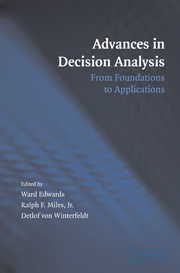Book contents
- Frontmatter
- Contents
- List of Contributors
- Preface
- 1 Introduction
- PART I HISTORY AND FOUNDATIONS OF DECISION ANALYSIS
- PART II STRUCTURING DECISION PROBLEMS
- PART III PROBABILITIES AND BAYES NETS
- PART IV UTILITIES
- PART V RISK ANALYSIS
- PART VI DECISION ANALYSIS IN A BEHAVIORAL AND ORGANIZATIONAL CONTEXT
- PART VII APPLICATIONS OF DECISION ANALYSIS
- 24 The Adoption of Multiattribute Utility Theory for the Evaluation of Plutonium Disposition Options in the United States and Russia
- 25 Choosing a Tritium Supply Technology for Nuclear Weapons: Reflections on a Controversial Decision Analysis
- 26 Applications of Decision Analysis to the Military Systems Acquisition Process
- 27 Balancing Environmental and Operational Objectives in Nuclear Refueling Strategies
- 28 Perspective on Decision Analysis Applications
- Index
- References
27 - Balancing Environmental and Operational Objectives in Nuclear Refueling Strategies
Published online by Cambridge University Press: 05 June 2012
- Frontmatter
- Contents
- List of Contributors
- Preface
- 1 Introduction
- PART I HISTORY AND FOUNDATIONS OF DECISION ANALYSIS
- PART II STRUCTURING DECISION PROBLEMS
- PART III PROBABILITIES AND BAYES NETS
- PART IV UTILITIES
- PART V RISK ANALYSIS
- PART VI DECISION ANALYSIS IN A BEHAVIORAL AND ORGANIZATIONAL CONTEXT
- PART VII APPLICATIONS OF DECISION ANALYSIS
- 24 The Adoption of Multiattribute Utility Theory for the Evaluation of Plutonium Disposition Options in the United States and Russia
- 25 Choosing a Tritium Supply Technology for Nuclear Weapons: Reflections on a Controversial Decision Analysis
- 26 Applications of Decision Analysis to the Military Systems Acquisition Process
- 27 Balancing Environmental and Operational Objectives in Nuclear Refueling Strategies
- 28 Perspective on Decision Analysis Applications
- Index
- References
Summary
The New York Power Authority (NYPA) wanted to develop a ten-year schedule for refueling its Indian Point 3 Nuclear Power Plant (IP3) that balanced fish protection, which occurs when IP3 is shut down for nuclear refueling, with the costs of buying and loading fuel. We developed a decision analysis model to compare alternative strategies for refueling. In the model, we explicitly considered key uncertainties associated with future operation: how well IP3 operates, how long it takes to refuel, and when New York State is likely to deregulate the electric utility industry. The NYPA decision makers used the model to reinforce their choice of a refueling strategy. They were not surprised that more fish protection occurred with strategies that restricted the starting date for refueling to the last full week in May, rather than allowing the starting date to float throughout the period from May through August. However, the NYPA decision makers were surprised that the more restrictive strategies also resulted in lower costs.
The NYPA is the nation's largest nonfederal public power organization, providing about one-fourth of the electricity used in New York State. The NYPA owns twelve power projects. The Indian Point 3 Nuclear Power Plant (IP3), located on the Hudson River, generates approximately one-fifth of its electrical power. Since 1975, IP3 has saved electric power users in Westchester County and New York City more than $1 billion.
- Type
- Chapter
- Information
- Advances in Decision AnalysisFrom Foundations to Applications, pp. 564 - 581Publisher: Cambridge University PressPrint publication year: 2007
References
- 1
- Cited by

